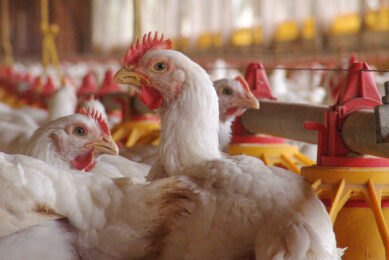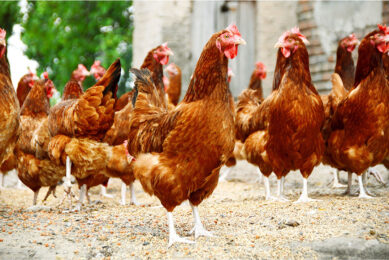Optimising gut health to overcome performance losses

Global climate change is influencing animal production even in temperate climates. As the number of days when the temperature humidity index exceeds animals’ comfort threshold rises, heat stress has become one of the most important ambient stressors in animal production worldwide.
Heat stress occurs as an animal’s heat gain exceeds the heat it can dissipate. Modern production animals, selected for rapid growth, are more susceptible to heat stress, and adverse effects include decreased productivity, susceptibility to infectious diseases and higher mortality.
Negative effects of heat stress
As heat stress immediately reduces feed intake, animals lose energy for growth and production. Redistribution of blood flow presents more challenges. During heat stress, blood vessels dilate, redirecting blood flow to the regions where heat can dissipate more easily: the skin. This reduces blood blow to the gastrointestinal tract (GIT) by as much as 40%.
Oxidative stress, damage from free radicals, is another concern. Studies show that hydrogen peroxide production increases up to 50% during heat stress. Simultaneously, maldondialdehyde (MDA) levels increase three-fold in the mitochondria and two-fold in muscle. This level of MDA emphasises the importance of protecting cells (especially GIT cells) from oxidative stress to prevent cell death and loss of functional tissue. Heat stress effects (free radical generation, intestinal hypoxia, gut barrier integrity disruption) occur before clinical symptoms appear, making avoidance essential. As recently uncovered mechanisms show heat stress has a direct effect on the GIT, preventative efforts must include gut health.

Reducing oxidative stress
When blood flow shifts to peripheral tissues during heat stress, internal organs, including the liver and intestines suffer from oxidative stress. Feeding antioxidants and osmolytes can mitigate this problem. However, antioxidant sources used to prevent heat stress effects must have a strong potential to neutralise the free radicals that cause oxidative stress. Vitamin E is used as an antioxidant in animal diets during heat stress, but has relatively little effect and works only in a lipid medium. Polyphenols are considered natural substances able to induce strong effects against free radicals generated in the GIT during heat stress. The most effective polyphenols for managing free radicals have high bioavailability and are active in both lipid and water-based tissues. Trouw Nutrition developed AOMix, a feed additive comprised of highly bio-available polyphenols with potent antioxidative properties. Supplementing AOMix during heat stress results in lower plasma MDA levels (Figure 1).
Figure 1 – Effect of vitamin E and Selko AOmix on plasma MDA levels in weaned piglets pre-and post-heat stress conditions.

Osmotic changes
Osmoregulatory interventions mitigate the breakdown of intestinal epithelial cells and prevent the adverse effects of heat stress on villus height, thus preserving the gut’s capability for optimal nutrient uptake. As reduced performance is a key challenge during heat stress, osmoregulators are recommended for supplementation before the start of hot seasons. Betaine is a trimethyl derivate of the amino acid glycine and a proven and effective osmoregulator. Trouw Nutrition’s TNIbetain effect on broiler performance was tested in heat stress conditions at the Nutreco Poultry and Rabbit Research Centre in Spain. Adding 1 or 2 g/kg TNIbetain significantly improved feed conversion ratio from 0 to 14 days of age and live weight at 40 days. The percentage of breast meat improved, especially in male broilers (+ 4.7%). Mortality was slightly lower for the highest level of TNIbetain. These results indicate TNIbetain can significantly improve broiler performance during heat stress.
Figure 2 – Presan reduced pro and inflammatory cytokines in heat stressed piglets which are messenger molecules of the immune system indicating inflammation.

Optimising gut health and function
Heat stress harms gut health and functionality. Research has shown increased immune cell infiltration into the gut wall of heat stress-exposed animals. This is likely due to loss of gut barrier integrity and the translocation of pathogens, bacterial compounds and small particles triggering an inflammatory response. Long-term heat stress may activate a mechanism in the small intestine to maintain homeostasis between commensal bacteria and the immune system. Presan helps stabilise gut microbiota, strengthen gut barrier integrity and support gut health during heat stress. Research shows Presan’s effects on weight gain and gut barrier function (Figure 2) compared to control groups. Trouw Nutrition invests in research to understand the underlying mechanisms of heat stress and develop effective management and nutritional approaches. As climate changes influence animal production, preventative strategies are essential.
References available upon request
Authors:
Dr Jessika van Leeuwen, Global Programme Manager Swine;
Melchior de Bruin, Global Programme Manager Poultry;
Sangeeta Singh, Global Programme Manager Lead Nutritional Solutions, Trouw Nutrition
 Beheer
Beheer





 WP Admin
WP Admin  Bewerk bericht
Bewerk bericht